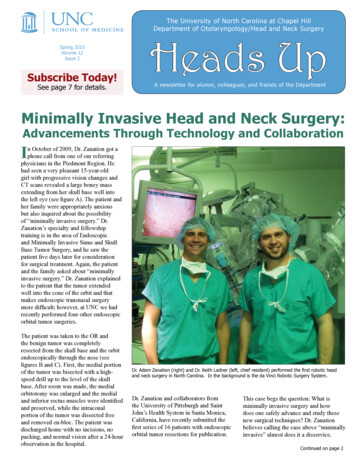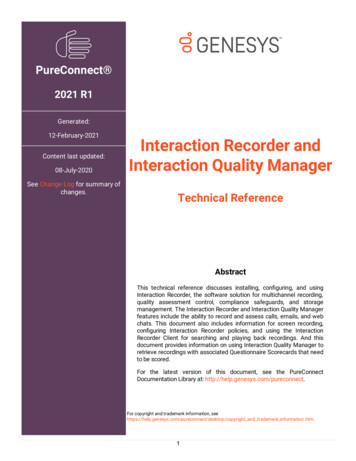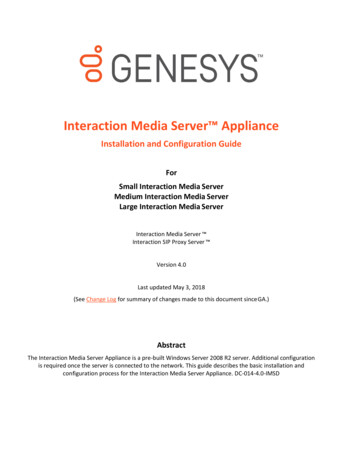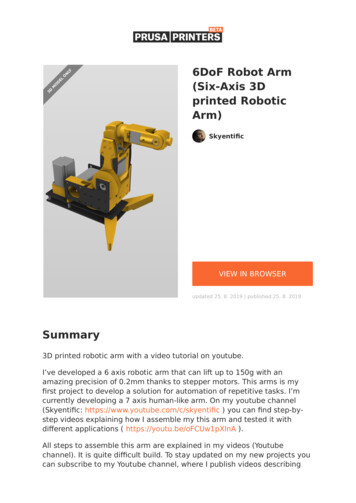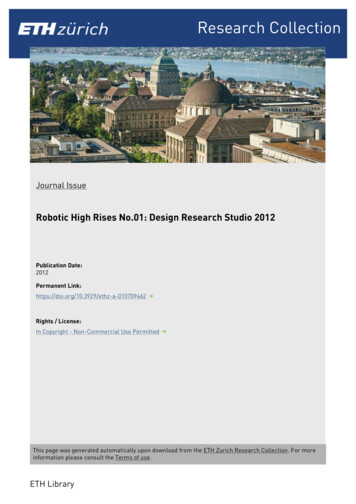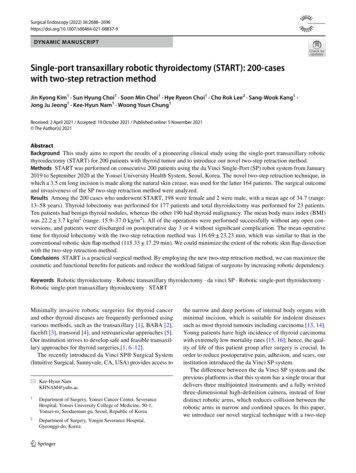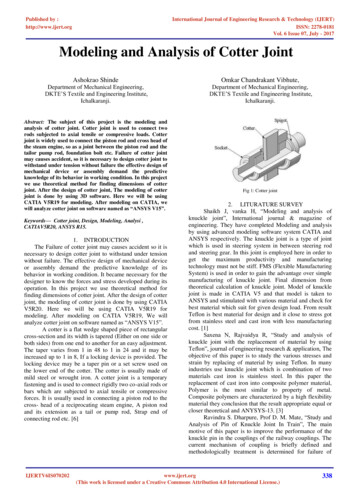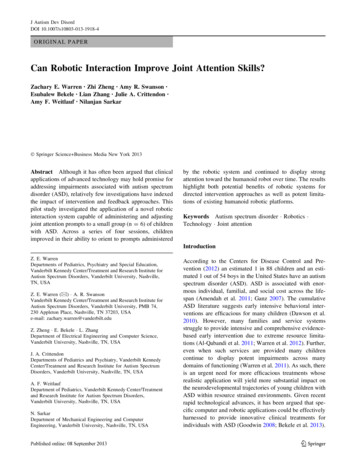
Transcription
J Autism Dev DisordDOI 10.1007/s10803-013-1918-4ORIGINAL PAPERCan Robotic Interaction Improve Joint Attention Skills?Zachary E. Warren Zhi Zheng Amy R. Swanson Esubalew Bekele Lian Zhang Julie A. Crittendon Amy F. Weitlauf Nilanjan SarkarÓ Springer Science Business Media New York 2013Abstract Although it has often been argued that clinicalapplications of advanced technology may hold promise foraddressing impairments associated with autism spectrumdisorder (ASD), relatively few investigations have indexedthe impact of intervention and feedback approaches. Thispilot study investigated the application of a novel roboticinteraction system capable of administering and adjustingjoint attention prompts to a small group (n 6) of childrenwith ASD. Across a series of four sessions, childrenimproved in their ability to orient to prompts administeredby the robotic system and continued to display strongattention toward the humanoid robot over time. The resultshighlight both potential benefits of robotic systems fordirected intervention approaches as well as potent limitations of existing humanoid robotic platforms.Keywords Autism spectrum disorder Robotics Technology Joint attentionIntroductionZ. E. WarrenDepartments of Pediatrics, Psychiatry and Special Education,Vanderbilt Kennedy Center/Treatment and Research Institute forAutism Spectrum Disorders, Vanderbilt University, Nashville,TN, USAZ. E. Warren (&) A. R. SwansonVanderbilt Kennedy Center/Treatment and Research Institute forAutism Spectrum Disorders, Vanderbilt University, PMB 74,230 Appleton Place, Nashville, TN 37203, USAe-mail: zachary.warren@vanderbilt.eduZ. Zheng E. Bekele L. ZhangDepartment of Electrical Engineering and Computer Science,Vanderbilt University, Nashville, TN, USAJ. A. CrittendonDepartments of Pediatrics and Psychiatry, Vanderbilt KennedyCenter/Treatment and Research Institute for Autism SpectrumDisorders, Vanderbilt University, Nashville, TN, USAA. F. WeitlaufDepartment of Pediatrics, Vanderbilt Kennedy Center/Treatmentand Research Institute for Autism Spectrum Disorders,Vanderbilt University, Nashville, TN, USAN. SarkarDepartment of Mechanical Engineering and ComputerEngineering, Vanderbilt University, Nashville, TN, USAAccording to the Centers for Disease Control and Prevention (2012) an estimated 1 in 88 children and an estimated 1 out of 54 boys in the United States have an autismspectrum disorder (ASD). ASD is associated with enormous individual, familial, and social cost across the lifespan (Amendah et al. 2011; Ganz 2007). The cumulativeASD literature suggests early intensive behavioral interventions are efficacious for many children (Dawson et al.2010). However, many families and service systemsstruggle to provide intensive and comprehensive evidencebased early intervention due to extreme resource limitations (Al-Qabandi et al. 2011; Warren et al. 2012). Further,even when such services are provided many childrencontinue to display potent impairments across manydomains of functioning (Warren et al. 2011). As such, thereis an urgent need for more efficacious treatments whoserealistic application will yield more substantial impact onthe neurodevelopmental trajectories of young children withASD within resource strained environments. Given recentrapid technological advances, it has been argued that specific computer and robotic applications could be effectivelyharnessed to provide innovative clinical treatments forindividuals with ASD (Goodwin 2008; Bekele et al. 2013).123
J Autism Dev DisordThe current pilot project examined the use of a novelrobotic technology as part of an interactive interventionenvironment for improving early joint attention skills inchildren with ASD.Work toward more impactful treatments has oftenfocused on improving early joint attention skills since theseskills are thought to be fundamental social communicationskills of the disorder (Kasari et al. 2008, 2010). Jointattention refers to a social exchange in which a childcoordinates attention between a social partner and anaspect of the environment. Fundamental differences inearly joint attention skills likely underlie the deleteriousneurodevelopmental cascade of effects associated with thedisorder (Dawson et al. 2010). The joint attention intervention literature to date suggests that early interventioncan systematically improve these skills and suchimprovements partially mediate improvements in othercritical developmental areas, including social and languageoutcomes (Kasari et al. 2010; Poon et al. 2011).Across interventions, which vary widely in terms ofscope and methodology, transactional approaches thatattempt to combine the advantages of developmental anddiscrete trial approaches via intensive graduated systems ofprompts in game-like, interactional frameworks hold substantial promise for improving these core skills (Yoder andMcDuffie 2006). Further, the accumulated sum of the earlyintervention literature to date suggests that social communication intervention approaches are most effectivewhen children show sustained engagement with a varietyof objects, can be utilized within intrinsically motivatingsettings, and when careful adaptation to small gains andshifts can be incorporated and utilized over time (Poonet al. 2011; Yoder and McDuffie 2006). Given these factors, as well as purported relative strengths and differencesin understanding physical and visual worlds relative tosocial worlds, responding to technologically cued feedback, and intrinsic interests in technology for many, but notall, young children with ASD (Annaz et al. 2012; Diehlet al. 2012; Klin et al. 2009), it is logical to hypothesizethat robotic technology could be used as a tool for thedevelopment of enhanced joint attention interventions.A number of research groups have studied the responseof children with ASD to both humanoid robots and nonhumanoid toy-like robots. Data from these groups havedemonstrated that many individuals with ASD show apreference for robot-like characteristics over non-robotictoys, and in some circumstances even respond faster whencued by robotic movement than human movement (seeDiehl et al. 2012 for review). Although this research hasprimarily been accomplished with school aged children andadults, research noting the preference for very youngchildren with ASD to orient to nonsocial contingenciesrather than biological motion suggests that downward123extension of this preference may be particularly promising(Annaz et al. 2012; Klin et al. 2009). In this regard, recentworks have documented that brief interactions with roboticsystems may result in concurrent increases in certainaspects of social behavior like language production (Kimet al. 2012) or enhanced social interactions (Duquette et al.2008; Feil-Seifer and Mataric 2011). While these approaches have certainly suggested the potential and value ofrobots for potential intervention applications, suchapproaches have not yet systematically examined howdirected robotic intervention and feedback approaches mayimpact core symptoms of impairment over time. Ultimately, questions of impact and generalization of skills arecritical for understanding the true value of adaptive roboticinteractions to ASD related intervention.In the current project, we tested over the course ofseveral sessions a novel adaptive robot-mediated architecture capable of administering joint attention prompts viahumanoid robot and contingently activating aspects of theintervention environment to enhance performance. Thisstudy built upon an initial feasibility study wherein wedeveloped a prototype system capable of administeringjoint attention tasks to young children with ASD (Bekeleet al. 2012, 2013). In this prior work, we developed a testbed that consisted of a humanoid robot NAO, a series of 23inch networked computer monitors capable of displayingrelevant recorded task stimuli, and an infrared camerasystem capable of inferring gaze based on a LED instrument baseball cap worn by the participant. We then compared performance and gaze detection for a sample of sixtypically developing children and six children with clinically confirmed ASD diagnosis (ages 3–5; IQrange 49–102) as well as variable baseline skillsregarding response to joint attention.Within this pilot system, a series of joint attentionprompts were administered via either a human administrator or the humanoid robot with randomized presentationto control order effect. The child sat in a chair across fromthe robot or interventionist for the trial block and wasinstructed through a hierarchy of prompts (i.e., head/gazeshifts, pointing, target activation) to look to a target. Thesystem registered gaze across all trials and provided reinforcement for looking through a simple reinforcementprotocol (e.g., praise and target activation). Available datasuggested that children with ASD spent approximately27 % more time looking toward the robot administratorthan the human administrator, that they did not fixate oneither robot or target, and ultimately directed gaze correctlyto the target for 95.83 % of the total 48 trials, a rate equalto TD success. Further, children successfully oriented torobotic prompting, meaning they responded to robotprompts prior to target activation, at very high levels (i.e.,ASD 77.08 % success; TD 93.75 %).
J Autism Dev DisordCollectively, these findings provide promising supportfor the capabilities and capacity of the current system toengage preschoolers with ASD. Preschool children withASD directed their gaze more frequently toward thehumanoid-robot administrator, accurately responded torobot administered joint attention prompts at high rates,and looked away from target stimuli at rates comparable totypically developing peers. This suggests that robotic systems endowed with enhancements for successfully pushingtoward correct orientation to target, either with systematically faded prompting or by embedding coordinated actionwith human-partners, might be capable of taking advantageof baseline enhancements in non-social attention preference (Klin et al. 2009; Annaz et al. 2012) to meaningfullyenhance coordinated attention skills. While this pilot dataprovided preliminary evidence that robotic stimuli andsystems may have some utility in preferentially capturingand shifting attention, at the same time such work did notprovide evidence that attentional preferences were eithersustained over time or that such preferences could actuallyimprove performance with repeated exposure. In thispresent work, we had young children participate in a seriesof four interaction sessions with our robot-mediated jointattention prompting system. We specifically hypothesizedthat children would demonstrate improved within-systemperformance on response to joint attention tasks and thatthey would not demonstrate substantially diminishedattention to the humanoid robot over this time frame.MethodsParticipantsSix children with ASD (age m 3.46, SD 0.73; seeTable 1) were recruited through an existing universitybased clinical research registry. All children had received aclinical diagnosis of ASD based on DSM-IV-TR (APA2000) criteria from a licensed psychologist, met the spectrum cut-off on the autism diagnostic observation schedule(ADOS; Gotham et al. 2007, 2009; Lord et al. 1999, 2000)administered by a research reliable clinician, and hadexisting data regarding cognitive abilities in the registry(Mullen Scales of Early Learning; Mullen 1995). Althoughnot selected a priori based on specific joint attention skills,varying levels of baseline abilities on the ADOS regardingformal assessments of joint attention (i.e., varied abilitieson Responding to Joint Attention item of the diagnosticinstrument) were present in the sample. The most recentassessments available in the registry for each child wereutilized for descriptive purposes (time between assessmentand enrollment, m 1.13 years, SD 0.65). Given thelag between original assessment and study participation allparents were asked to complete both the Social Communication Questionnaire (SCQ) (Rutter et al. 2003) and theSocial Responsiveness Scale (SRS) (Constantino andGruber 2002) to index current ASD symptoms (seeTable 1).ApparatusThe system was designed and implemented as a component-based distributed architecture capable of interactingvia network in real-time. System components included (1)a humanoid robot that provided joint attention prompts, (2)two target monitors that could be contingently activatedwhen children looked toward them in a time synchedresponse to a joint attention prompt, (3) an eye tracker andlinked camera system to monitor time spent looking at therobot facilitator and judge correct performance, and 4) aWizard-of-Oz style human control system to mark correctperformance. The term Wizard-of-Oz is commonly usedwithin the field of human–computer interaction to describesystems that appear to operate autonomously to the participant, but are actually at least partially operated byunseen human administrators.Humanoid RobotThe robot utilized, NAO (see Fig. 1), is a commerciallyavailable (Aldebaran Robotics Company) child-sizedplastic bodied humanoid robot (58 cm tall, 4.3 kg) utilizedin other recent applications for children with ASD (Bekeleet al. 2012; Gillesen et al. 2011). In this work, a new rulebased supervisory controller was designed within NAOwith the capacity to provide joint attention prompts in theform of recorded verbal scripts, head and gross orientationof gaze shifts, and coordinated arm and finger points.Table 1 Participant 071.0017.00SD0.7320.291.861.059.386.32MSEL Mullen scales of early learning, ADOS CS autism diagnosticobservation schedule comparison score, ADOS RJA autism diagnosticobservation schedule response to joint attention, SRS-2 socialresponsiveness scale-second edition, T-score, SCQ social communication questionnaire lifetime total score123
J Autism Dev DisordPrompts were activated based on real-time data providedback to the robot by a human facilitator.Eye TrackerWe utilized a remote desktop Tobii120 eye tracker to indexparticipant gaze toward the robot during the task. It controls a calibrated camera that records the participant’s viewof the robot, which is streamed to the video feed shown atthe monitoring station. This allows the technician tomonitor each participant’s eye gaze in real time. To calibrate the eye tracker, the participant sits in the center of theroom and views eye gaze calibration slides projected on toa screen. The calibration slides contain a small cartoon onthe calibration point as well as music to catch the participant’s attention. After calibration, the screen was removedand the robot was positioned at the calibration point. The‘‘robot attention gaze region’’ was defined as a box of76 cm 9 58 cm which covered the body and movement ofNAO. Given the distance from the participant to the calibration screen/robot, the accuracy of gaze detection if theparticipant moved his or her head was about 5 cm in boththe horizontal and vertical directions.Target MonitorsTwo 24 inch computer monitors hung at identical positionson the left and right sides of the experimental room. Theflat screen monitors displayed static pictures of interest atbaseline, but also played brief audio files and video clipsbased on study protocol. The target monitors were58 cm 9 36 cm (width 9 height). They were placed atlocations approximately perpendicular to the participantssuch that target orientation would often require substantialhead movement in addition to gaze shifts to aid in classification of successful orientation (see Fig. 2 for a diagramof the room arrangement).Wizard-of-Oz Human Control SystemA live video feed of the participant was streamed to amonitoring station where a technician continually monitored the participant performance. If the participant followed the robot’s instruction by looking toward the target,the technician hit a button to trigger correct looking. Thismarker would cue the system to provide reinforcement inaccordance with the defined protocol. If the participant didnot follow the robot’s instruction within 7 s of the prompt,the system registered the lack of a successful response andproceeded to the next level of prompting until all sixprompts were administered. Timing of prompts and thetime window for correct response was embedded within thesystem architecture (i.e., the technician was not responsiblefor gauging the 7 s window). The prototype systemdeveloped in our original work (Bekele et al. 2012, 2013)was capable of automatic inference of gaze via headtracker and as such realized closed-loop adaptation (i.e.,system capable of adjusting itself without human facilitation). However, in terms of tolerability, 40 % of our ASDsample was not able to tolerate wearing the instrumentedcap. As such, we utilized a Wizard-of-Oz paradigm to testchange over time as an interim step to determine the relevance of future movement toward a non-invasive computer vision detection methodology with potential forclosed–looped interaction.Design and ProceduresParticipants came to the lab for four lab visits over thecourse 2 weeks on average (average days 14; SD 9.6;range 4–30). Informed consent was obtained from allFig. 1 Humanoid robot123Fig. 2 Apparatus and room arrangement
J Autism Dev DisordTable 2 Prompt content for each level within trialsPromptlevelRobot speechRobot motionTarget display1‘‘Jim, look!’’Turn headStatic picture2‘‘Jim, look!’’Turn headStatic picture3‘‘Jim, look over there!’’Turn head and pointStatic picture4‘‘Jim, look over there!’’Turn head and pointStatic picture5‘‘Jim, look over there!’’Turn head and pointAudio display(3 s)6‘‘Jim, look over there!’’Turn head and pointVideo display(10 s)participating parents. At the initiation of each sessionparticipants were introduced to the experiment room andgiven time to explore the robot. The child was then seatedin a Rifton chair at a table across from the robot with theparent was seated behind the child. Parents were instructedto avoid providing assistance to the child during the study.After initial eye tracker calibration, participants then participated in a series of joint attention trials. Each sessionincluded eight trials (see Table 2), for a total of 32 trialsacross all sessions.At the beginning of each session, participants were toldthat they were going to play a game. The robot then greetedthe participant (‘‘Hi Jim. My name is Nao. I want you tofind some things. Okay, ready?’’) and provided the firstprompt (‘‘Jim, look!’’).Trial FormatEach trial included up to six potential prompt levels. Foreach trial, the system randomly put the target on the left orright monitor for the trial’s duration. The robot turned itshead or turned while pointing to the corresponding target.After the start of each prompt, a 7 s response time windowwas set. ‘‘Target hit’’ was defined as the participantresponding to (i.e., turning to look at) the correct targetwithin this 7 s window. Regardless of the participantresponse, the robot turned back to a neutral position(standing straight and facing the participant) after eachprompt.The technician continually monitored the participant’sperformance using direct observation and the calibratedeye tracking system. If the participant followed the robot’sinstruction by looking at the target, the technician hit abutton to trigger a reward (a clip from a children’s cartoon)and start the next trial. If the participant did not follow therobot’s instruction within 7 s of the prompt, the systemregistered the lack of a successful response and proceededto the next level of prompting until all six prompts wereadministered.The hierarchy moved children from simple name and gazeprompts, to prompts also combining pointing, to promptscombining all those plus audio and/or visual activation. Ineach trial, a 10-s video clip was turned on contingent to theregistration of child success by the system, or at the conclusion of the prompts. These video clips were short musicalvideo segments of common preschool television programs(e.g., Bob the Builder, Dora the Explorer, Sesame Street etc.)that were randomized across trial blocks and participants(see Bekele et al. 2013 for details of video selection).Although trial time varied as a function of performancewithin system, and sessions including warm-up and introduction took substantially more time, the trials themselveswith system were accomplished over a fairly brief timewindow (m 4.93 min, SD 1.05).ResultsThe primary objective of this study was to empirically testchild performance in response to within system jointattention prompts over a series of sessions. The secondaryobjective was to assess attention to the humanoid robotover time. We hypothesized (1) children would beresponding to the humanoid robot at lower levels ofprompting within the hierarchy from baseline to outcome,and (2) children would not demonstrate diminished attention to the robot over time. As such, we analyzed target hitrates to assess change from baseline to final performance aswell as time spent looking toward the robot across a similartime frame.Target Hit RateAcross all sessions and participants, 99.48 % of the 32trials ended with a target hit. The average prompt levelbefore participants hit the target is shown in Fig. 3, whichdisplays how participant performance, as measured by thenumber of prompts needed before a successful target hit,improved across sessions. In Session 1, the average targethit prompt level was 2.17 (SD 1.49) with the averageFig. 3 Average prompt level of target hits across sessions123
J Autism Dev Disordtarget hit prompt level falling to 1.44 (SD 1.05) bySession 4. A two-sided Wilcoxon rank-sum test indicatedthat the median difference between Session 1 and Session 4was statistically significant (p .003).In examining individual performance of children overtime, five of the six participating children exhibited loweraverage levels of prompt level target hit across session (seeFig. 4). We next examined specific performance by promptlevel. Specifically knowing that prompts 5 and 6 involvedtarget activation in the form of audio and/or video activation, we wanted to determine if children showed anincreased ability to respond to gaze and point shiftsdelivered by the robot prior to such activation (see Fig. 5).On average, participants responded to the first press of therobot more frequently across sessions and showed highlevels of response prior to prompts that used an element oftarget activation. Specifically, in Session 1, 52.8 % of trialsnumber was 81.25 % (p \ .05). Participants hit the targetwithin the first four prompts 87.5 % of the time in Session1 and 95.83 % of the time in Session 4. We also examinedwithin session performance for individual children byindexing the total number of sessions where there was clearreduction or increase in prompt levels defined by C1 levelof change in prompt level during an individual session.Within session prompt performance was present in only arelative minority of trials (25 %) with a majority of sessions demonstrating either unclear within session change(46 %) and the remaining session actually demonstratingincreases in within session prompting. These results suggest that there while there was clearer improvement overtime and across sessions for this group, specific improvement within individual sessions was not as clearly evidentnor a reliable predictor of change over time.Attention Toward RobotFig. 4 Average participant prompt level for target hitended with a target hit on prompt 1; by Session 4, thatWe analyzed eye gaze patterns in two ways: (1) Across thewhole session (from the start of the first prompt to the endof the session), and (2) Within the 7 s response time window across all prompts within a trial. Movement restrictions related to eye-tracker calibration resulted in somedata loss very much in line with other work regarding eyetracker use and young children (Sasson and Elison 2012).There was a trend for lower levels of data loss over time,with estimates of 30 % data loss for Session 1 and less than10 % for subsequent sessions.The average time that participants looked at the robotacross all sessions was 14.75 % of the total experimenttime. Within the 7 s window, the average time that theparticipants looked at the robot across all sessions was24.80 %. From Session 1 to Session 4, participants’ average times looking at the robot region were 14.88, 15.17,17.94, and 11.02 % for the whole session, and 22.15,26.52, 28.14, and 22.41 % for the 7 s response window.Two-sided Wilcoxon rank-sum tests showed that thesedifferences in looking time across sessions were not statistically different.DiscussionFig. 5 Target hits on initial prompt (prompt 1) and prior to targetactivation (prompts 1–4)123In the current pilot study, we studied the development andapplication of an innovative adaptive robotic system withpotential relevance to core areas of deficit in young children with ASD. The ultimate objective of this study was totest children’s performance over time across interactionswith a humanoid robot-based system capable of administering and altering a joint attention hierarchy based onperformance. Within our small sample, children with ASDdemonstrated improved performance within system across
J Autism Dev Disordsessions and documented sustained interest with thehumanoid robot over the course of interactions. Thesefindings together are promising in both supporting systemcapabilities and potential relevance of application. Despitepromise, available pilot data are not yet sufficient forsuggesting that such short-term changes may translate intobroader changes beyond the experimental paradigm itself.In line with previous findings, children with ASD in oursample were quite often able to respond accurately toprompts delivered by a humanoid robot within the standardized protocol (Bekele et al. 2013). Further, participantsalso spent a significant portion of the experimental sessionslooking at the humanoid robot, replicating other worksuggesting that young children with ASD show attentionalpreferences for robotic interactions over brief intervals oftime (Bekele et al. 2013; Dautenhahn et al. 2002; Duquetteet al. 2008; Kozima et al. 2005; Michaud and ThébergeTurmel 2002; Robins et al. 2009). In addition, within thecurrent work we also documented that children coulddemonstrate improved performance over time in a basiccore social communication skill and area of deficit (i.e.,response to joint attention) and that over the course ofsessions, children maintained interest in the humanoidrobot central to platform.Although children in this sample demonstrated variablebaseline joint attention skills both within system and ascoarsely indexed by ADOS response to joint attention itemscores, all but one of our participants (83 % of total sample) documented improved joint attention response overtime. Further, children successfully followed the humanoid’s gestures and movements to accurately orient to targets, orienting prior to target activation in 95.83 % of trialsin the final session. Collectively, these findings suggest thatrobotic systems endowed with mechanisms for successfullypushing participants toward correct orientation to target,via a behaviorally sophisticated prompting and reinforcement system, might be able to capitalize on non-socialattention preferences for many children with ASD in orderto meaningfully enhance skills related to coordinatedattention over time.Despite this potential, the current system only provides apreliminary structure for examining ideal instruction andprompting patterns for a humanoid robotic system. Futurework examining prompt levels, the number of prompts,cumulative prompting, or a refined and condensed promptstructure would likely enhance future applications of anysuch system. Although our data provides preliminary evidence that robotic stimuli and systems may have someutility in preferentially capturing, shifting, and attention, itis unclear how such performance would compare toinstruction provided by a human administrator in the current study. In many of their current forms, humanoid robotsare not as capable of performing sophisticated actions,eliciting responses from individuals, and adapting theirbehavior within social environments as their humancounterparts. Though NAO is a state-of-the-art commercialhumanoid robot, its interaction capacities have numerouslimits. Its limb motions are not as fluid as human limbmotions, it creates noise while moving its hand that is notpresent in the human limb motion, flexibility and degreesof freedom limitations produce less precise gesturalmotions, and its embedded vocalizations have inflectionand production limits related to its basic text-to-speechcapabilities. As such, it is extremely unlikely that the mereintroduction of a humanoid robot that performs a simplecomparable action of a human in isolation will drivebehavioral change of meaning and relevance to ASDpopulations. Robotic systems will likely necessitate muchmore sophisticated paradigms and approaches that specifically target, enhance, and accelerate skills for meaningfulimpact on this population.There are several significant methodological limitationsof the current study that are crucial to highlight. Thesmall sample size examined and the limited time frame ofinteraction, although significantly expanded from previouswork, are the most powerful limits of the current study.Further, although we had standardized assessments ofthose children who participated, there was a substantiallag between assessment and enrollment which somewhatlimits our ability to understand fully the sample participating in this study. While we are left with data suggesting the potential of the appl
230 Appleton Place, Nashville, TN 37203, USA e-mail: zachary.warren@vanderbilt.edu Z. Zheng E. Bekele L. Zhang Department of Electrical Engineering and Computer Science, Vanderbilt University, Nashville, TN, USA J. A. Crittendon Departments of Pediatrics and Psychiatry, Vanderbilt Kennedy Center/Treatment and Research Institute for Autism Spectrum
